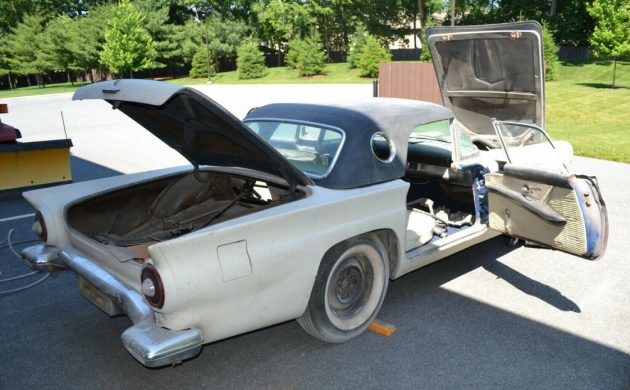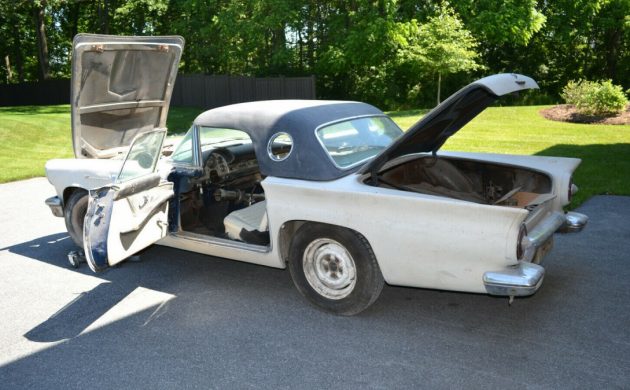By 1957, the Ford Thunderbird was firmly entrenched in the American new car market. While many people today perceive the 1st Generation Thunderbird as a sports car, Ford aimed to produce a comfortable roadster. They succeeded in this aim, and 21,380 people happily handed over their hard-earned cash to park one in their driveway. This particular example is a solid vehicle that is just begging to be restored. Its single strongest attribute is the fact that it appears to be rust-free. That makes it a strong contender for anyone who is searching for a project that they can tackle in their home workshop. The T-Bird is located in Lititz, Pennsylvania, and has been listed for sale here on eBay. It has a BIN of $18,500, but there is the option available to make an offer.
The owner supplies only a few exterior photos of the Thunderbird, but I chose to include this one of the underside. The Ford is said to have spent its life in California. That would help to explain the fact that there is little beyond a light dusting of surface corrosion to be found underneath the car. The floors and frame appear to be sound, while there are no issues visible in the trunk. Externally, there are no signs of any rust problems, and there is no evidence of any prior rust repairs. It would appear that the majority of the trim and chrome is present, although it is hard to determine its condition. There is also a factory hardtop, and both this and the tinted glass look to be in good condition. I do believe that this is a classic that might have quite a story to tell. When it rolled off the production line, it wore Gunmetal Gray paint. Since then, there is evidence visible to suggest that it has received several repaints. The color palette involved includes a shade of light blue, then dark blue, and finally, its present shade of white.
The T-Bird features a D-Code 312ci V8, backed by a 3-speed Ford-O-Matic transmission. This engine would have produced 245hp and allowed the vehicle to cover the ¼ mile in 16.4 seconds. Of course, Ford wasn’t marketing the Thunderbird as a sports car, so they weren’t focused on outright performance. However, this level of performance is still very respectable. It is made even more so when you consider the fact that the Chevrolet’s Corvette was supposed to be a more sporting vehicle. The best that it could muster in automatic form was to match this car’s ¼ mile ET…and this wasn’t even the most potent version of the T-Bird available in 1957! More positive news comes in the form of this classic being in a mechanical state where it runs and drives. It isn’t clear whether it is roadworthy, but this isn’t a bad start. There are no interior photos, but we do know that it originally would have been upholstered in a combination of black and white. It would appear from a distance as though it is complete and that the dash might be in good condition. Beyond that, I can see that the door trims and carpet will require replacement. It is impossible to ascertain the state of the seat.
It is pretty common to find 1975 Thunderbird project cars with at least some rust that requires attention. This one doesn’t have those issues and would seem to represent a fairly straightforward restoration project. That is why I feel that it could potentially be tackled in a home workshop. Clean examples can currently sell quite readily for $40,000, but $60,000 for a pristine example is not out of the question. Even if you consider that lower figure as you ballpark, that leaves a lot of room to move on restoration at the BIN price. That makes this car an exciting proposition.









Nice find with the port hole roof. The “cheapest” tri-bird with Amos Minter is $65 large…everything else is $70-$100.
Being at the end of the baby-boomers age range I hope to catch a deal on something before I “age out”. Sorry if that’s a bit dark.
Sam61, don’t give up on your dream. You don’t have to go to a dealer to get a nice car. Join a club related to the car of your dreams and participate (meetings, conventions), meet the other members, and you will be able to purchase a nice car before it even hits the market. I know people given first shot at cars at favorable terms because people want their car go ‘to a good home.’
seems high for what it is and the condition it is
The engine has the self destruction Callif. Nox smog device. Hole in valve cover and air cleaner lid. There will be 2 holes drilled for and aft of the carb into the intake manifold. These 2 holes in intake then have a diaphram valve into the valve cover. Timing is then set to zero. That burns an engine up because you are told to not exceed 60 mph. Stupid kommiphonia crap.
Sounds horrible.
That’s not a NOx devise, that’s a Positive Crankcase Ventilation system. It’s using intake vacuum to suck blow-by and fumes out of the crankcase, up the oil filler tube, the cap and the hose routed to the PCV device installed in the aircleaner lid. PCV devices eliminated road draft tubes which did a poor job of venting the crank case but did expel a pretty constant mist of oil coating the underside of your car, left a hazardous slick of oil in the middle of every traffic lane, fouled the air and stank. If you don’t vent the crank case you will soon have sludge and ruin your engine. A PCV system is a good thing. California required them starting in 1961. Many cars made before 1961 were retrofitted like this one. Or not. My best friend bought a beautiful 1956 Bird in the early 1970s.. Closer examination after purchase revealed a draft tube that had been crimped closed at the bottom. No PCV system had been fitted. The motor which had been rebuilt was full of sludge.
I don’t see evidence of a NOx device on this car. Emissions regulation became more stringent throughout the 1960s. Starting in 1966 California required all new cars have mandatory emissiions control devices. That brought us things like Ford’s Thermactor Air Injection system with the belt driven pump and fresh air tubes running into each intake port. The 1968 Pure Air Act established stricter standards for 1970-1974 vehicles. The Clean Air Act Amendments of 1970 established Federal standards and preempted individual states standards except for California. The Feds used California as a model and California was always at least one year ahead of any Federal standards. Tailpipe emissions including NOx testing started after 1970.
By 1971 it became evident that the 1966-70 era emission control devices had reduced Hydrocarbon and Carbon Monoxide substantially it had done so by increasing NOx emissions. The early devices worked by leaning out the fuel mixture. The susequent increased combustion temperatures produce greater amounts of NOx. This was when the NOx device retrofit came into existence. They were to be installed when vehicles were sold and became the responsibility of the new owner. At the same time regulations for 1955-1965 cars were tightened.
I remember buying several cars that had passed through several owners without being registered to any of them. Apparently properly registering and smogging a car back then was just too much for some people. It wasn’t. As long as you had the pink-slip and bill of sale of some kind you were good. People were pretty slack back then.
Yep, that’s definitely a homemade crankcase ventilation system. There is a bit of a problem with how it is plumbed though. There is no provision to prevent an engine backfire from igniting the crankcase fumes.
I love these cars. I’m too far away for this one. And I have no room. Negotiations for larger space broke down. Landlord is an idiot. Looking at alternatives. I’m 82 years old and not out of the hobby yet.
Everybody wash your hands and wear a mask.
The pics on EBay show major repair – looks like patch panels welded in on the passenger side rear
I wouldn’t mind having this car for hobby work, but alas! Misfortune has recently come my way depleting any funds for such an adventure. I’ll just keep tinkering with my 64 Riviera and perhaps the sun will shine again in my life. Sorry for the gloom but that’s how I feel right now.
God bless America
Don’t see a front sway bar – should 1 be there?
It amazes me that cars like this are still being found stashed away. They were worth so much money a few years ago. But perhaps many are “future projects” that never happened and now many of the boomers are beginning to pass.
The smog stuff sound horrible!! I have never had to deal with that crap!!
I also like PCV cause it doesnt lower HP. & i wish all 50’s & 60’s cars had the evap emission controls like later 70’s cars to keep all gas fumes out of the garage while just sitting – again no HP impact.
The guys in my Little British Car universe take off almost everything from the A series and Triumph engines that were mandated to go into sports cars destined for the US beginning around 1972. With the exception of charcoal canisters for fuel vapor out of the carbs and vapor recovery systems emanating from the gas tank. Those remain, and make one’s shop a little less stinky when you pull your roadster in after a long days’ drive. Or attempt to do anything with the engine running.
This is way overpriced. Our fathers who craved these cars are passing away, and demand is definately down. Sold one like this(California car) 7 years ago for ~$20k in much better shape with only 75k miles. My buddy had trouble sellng his that was much nicer a couple of years later for the low-mid 20’s. I agree that its best to find your nearest T- Bird club. There are a lot of much nicer cars where the aging owners or families just want it to go to a good home. This is not worth his price….